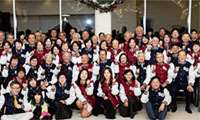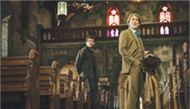The American television series “Mad Men,” for example, depicts an early ‘60s advertising agency awash in booze: sherry in the morning, gin at lunch, whiskey in the afternoon. “Those years, for lunch, they used to drink three martinis,” Carlo Marioni, 65, a New York bartender, told Robert Simonson of The Times. “Then they’d come back before dinner for rusty nails, white spiders.”
But employers now are more circumspect about mixing work and drink. Cy Wakeman, president of a human resources firm in Iowa, said that when drinking with colleagues, “the risk is very high that something negative will come out of it,” Eilene Zimmerman reported in The Times.
Does the same hold true for wizards? Writing in The Times, Tara Parker-Pope said that some American parents were alarmed by drinking scenes in “Harry Potter and the Half-Blood Prince,” the latest installment in the movies based on J. K. Rowling’s fantasy series. The teenage heroes Harry, Ron and Hermione drink a concoction called butterbeer. Dr. Christopher Welsh, a University of Maryland psychiatrist and addiction specialist, told Ms. Parker-Pope, “I hope parents can talk to their kids and tell them even though Harry Potter made that seem fun, that it isn’t O.K.”
Ms. Parker-Pope noted that non- American audiences were likely to see it differently. The United States sets its legal drinking age at 21, higher than most European, Asian and Latin American countries.
But in Australia, where the drinking age is 18, concerns about liquor have taken on urgency in some Aboriginal communities that have been decimated by addiction and violence. The federal government and some local Aboriginal governments are trying to limit alcohol availability in parts of the outback. “We know what life was like before alcohol,” Doreen Green, 65, an Aboriginal schoolteacher in Halls Creek, told Norimitsu Onishi of The Times. “We had a proud race of people, very together people. Then alcohol just took over.”
Despite alcohol’s social costs, there are social benefits as well - a fact recognized at the highest levels of government. In July, President Obama invited the aggrieved parties in a disputed arrest to have a beer together at the White House. A black Harvard professor and the white police officer who had charged him with disorderly conduct made the journey to Washington from Cambridge, Massachusetts. The media avidly reported the drink choices of each man (Mr. Obama had a light beer). Left mostly unspoken in the coverage was the assumption that the simple act of drinking together was a way to establish a bond, however fleeting, between strangers.
It is an assumption shared by the ad men of “Mad Men,” and maybe the wizards of Hogwarts as well. And it helps explain why, in many places, the bottle remains a fixture when people socialize. As they say in Ethiopia, “Letenachin!”
For comments, write to nytweekly@ nytimes.com.
스마터리빙
more [ 건강]
[ 건강]이제 혈관 건강도 챙기자!
[현대해운]우리 눈에 보이지 않기 때문에 혈관 건강을 챙기는 것은 결코 쉽지 않은데요. 여러분은 혈관 건강을 유지하기 위해 어떤 노력을 하시나요?
 [ 건강]
[ 건강]내 몸이 건강해지는 과일궁합
 [ 라이프]
[ 라이프]벌레야 물럿거라! 천연 해충제 만들기
 [ 건강]
[ 건강]혈압 낮추는데 좋은 식품
[현대해운]혈관 건강은 주로 노화가 진행되면서 지켜야 할 문제라고 인식되어 왔습니다. 최근 생활 패턴과 식생활의 변화로 혈관의 노화 진행이 빨라지고
사람·사람들
more많이 본 기사
- ‘인니 수마트라섬 대홍수’ 사망자 1천명 넘어…218명 실종
- 시리아서 미군 피격, 3명 사망… “시리아군 내 극단주의자 소행”
- 韓 탁구 최초 역사… 신유빈-임종훈, 세계랭킹 1위+파리올림픽 金 듀오 꺾고 WTT 파이널스 우승
- 美, 카리브해 군사자산 확대… “베네수엘라에 지상·전자전 위협”
- 뉴욕 백화점서 아기 기저귀 갈던 엄마, 정신질환자에 흉기피습
- 트럼프 “태국·캄, 교전 중단 합의”…태국 “군사 작전 계속”
- ‘손흥민 벽화 3일 만에 그린’ 예술가, SON과 감격 만남 후 “내 아들의 영웅이자 아시아 유산” 찬사
- 트럼프 “인디애나 선거구 조정 반대한 공화의원들, 교체돼야”
- 한소희, 韓 떠나기 전 의미심장 SN… 1
- 與, 은행법 처리뒤 ‘경찰관직무집행법’ 상정…국힘 또 필버
- 이정후 태극마크 ‘청신호’ 떴다! 스타 출신 SF 사장 “야수보단 투수가 WBC 위험”→걸림돌 사라졌다
- 김연아♥고우림, 사랑하니 닮아가네..예쁜 커플사진
- 내란특검, 김용현 추가 기소… “HID요원 등 명단 노상원에 넘겨”
- “현실 기반 대북정책 필요”
- TV 나와 암투병 근황 공개한 찰스 英국왕… “조기검진 중요해요”
- 송지효 “’런닝맨’ 출연 중 8년 ♥장기 연애했다” 폭탄 고백..멤버 모두 ‘충격’
- 선교사 아들 가나대사로 금의환향… “… 1
- 변요한♥티파니, 결혼 전제 열애 인정
- 신혼부부 ‘역대 최저’ 24%는 3억 이상 대출
- 美 레전드 깜짝 전망 “한국, 북중미 월드컵 A조 1위로 32강”
- ‘나혼산’ 박나래, 흔적도 없이 하차… 1
- 통일교 특검 대신 “내란 2차 특검”… 민주당 ‘철벽 방어’
- 굽히지 않는 젤렌스키…트럼프에 역제안 카드로 레드라인 저지
- 김하성-ATL, 이대로 헤어지나→윈터미팅서만 무려 1005억 지출해버렸다
- 한화, 호주 방산업체 최대주주 된다
- 한국 교사 10명, 페어팩스 초등교 배치
- ‘오바마케어 보조금’ 올해 말 종료 가능성 ↑ 커져
- 김지민 “유부남과 불륜, 날 알리바이로 이용”..친구와 손절한 사연 [이호선의 사이다]
- “보안사고 반복 땐 과징금 폭탄”… 해킹과 전면전 선포한 과기부
- 소셜연금 NY 2,018달러·NJ 2,190달러
- “마약밀매·인신매매 등 국제범죄 척결” ‘국토안보 태스크포스’ 뉴욕지부 출범
- “’삐빅’ 비트코인으로 결제할게요”…맥도날드·편의점서도 쓴다는 ‘이곳’, 어디?
- “엔비디아, 中수요 반영 H200 증산”…일각선 “中, 수입거부할듯”
- ‘양육비 미지급’ 김동성 “내가 月700만원? 통장 압류된 신용불량자”
- 기아 EV5, 넷플 ‘나이브스 아웃’ 협업 캠페인…세계 6개국 진행
- “귀금속 역사상 가장 극적인 재평가”…올해는 銀이 金 앞섰다 [공준호의 탈월급 생존법]
- 뉴욕증시, 브로드컴 비관론에 AI 테마 ‘와르르’…나스닥 1.7%↓ 마감
- 제미나이 추격 오픈AI 새 모델 GPT-5.2 조기 공개
- ‘정국 열애설’에 뿔난 아미 ‘워워’..BTS 완전체, 전역→웃으며 연습실 회동 첫 인증샷
- 한국도 참여한 美주도 AI 동맹 “비… 1
- 종묘 일대 세계유산지구로 세운4구역 개발 영향 줄까
- AI공급망 동맹 ‘팍스 실리카’ 8개국 참여
- “머스크의 X, 3분기 매출 7억 달러대…순손실 5억 달러대”
- ‘고가 논란’ 북중미 월드컵 티켓, 판매 첫날 500만건 신청
- 초강경 추방 드라이브… 한인사회 불안감 확산
- 미네소타 보조금 사기, 안보 문제로 … 1
- 트럼프, 중남미 마약카르텔 공습 확대의지… “지상서도 시작한다”
- 美지상작전 임박설 속 베네수 이민자 송환 중단 놓고 ‘혼선’
- 국힘·개혁신당 “통일교 특검 수용하라”…與 “정치공세·물타기”
- PCB, 전국 최고 중소은행 ‘올스타’ 선정
1/5지식톡

-
 테슬라 자동차 시트커버 장착
0
테슬라 자동차 시트커버 장착
0테슬라 시트커버, 사놓고 아직 못 씌우셨죠?장착이 생각보다 쉽지 않습니다.20년 경력 전문가에게 맡기세요 — 깔끔하고 딱 맞게 장착해드립니다!장착비용:앞좌석: $40뒷좌석: $60앞·뒷좌석 …
-
 식당용 부탄가스
0
식당용 부탄가스
0식당용 부탄가스 홀세일 합니다 로스앤젤레스 다운타운 픽업 가능 안녕 하세요?강아지 & 고양이 모든 애완동물 / 반려동물 식품 & 모든 애완동물/반려동물 관련 제품들 전문적으로 홀세일/취급하는 회사 입니다 100% …
-
 ACSL 국제 컴퓨터 과학 대회, …
0
ACSL 국제 컴퓨터 과학 대회, …
0웹사이트 : www.eduspot.co.kr 카카오톡 상담하기 : https://pf.kakao.com/_BEQWxb블로그 : https://blog.naver.com/eduspotmain안녕하세요, 에듀스팟입니다…
-
 바디프렌드 안마의자 창고 리퍼브 세…
0
바디프렌드 안마의자 창고 리퍼브 세…
0거의 새제품급 리퍼브 안마의자 대방출 한다고 합니다!8월 23일(토)…24일(일) 단 이틀!특가 판매가Famille: $500 ~ $1,000Falcon: $1,500 ~ $2,500픽업 & 배송직접 픽업 가능LA…
-
 바디프렌드 안마의자 창고 리퍼브 세…
0
바디프렌드 안마의자 창고 리퍼브 세…
0거의 새제품급 리퍼브 안마의자 대방출 한다고 합니다!8월 23일(토)…24일(일) 단 이틀!특가 판매가Famille: $500 ~ $1,000Falcon: $1,500 ~ $2,500픽업 & 배송직접 픽업 가능LA…
케이타운 1번가
오피니언

22기 LA평통 출범에 거는 기대

연말 시즌 사기·범죄 경계해야
 메건 매카들 워싱턴포스트 칼럼니스트
메건 매카들 워싱턴포스트 칼럼니스트 [메건 매카들 칼럼] 장편영화의 마지막 챕터인가
 김미선 서북미문인협회 회장시인
김미선 서북미문인협회 회장시인 [한국춘추] 하늘을 계산한 사람들, 칠정산
 이희숙 시인·수필가
이희숙 시인·수필가 [금요단상] 그을린 자리에서 다시
 심상용 / 서울대 미술관장
심상용 / 서울대 미술관장 [미술 다시보기] 지옥에 대하여
 서정명 / 서울경제 기자
서정명 / 서울경제 기자[만화경] 주한미군과 ‘도련선 리스크’
 한 영 재미수필가협회 회장
한 영 재미수필가협회 회장 [한영의 독서칼럼] 불안한 사람들
 정영현 서울경제 테크성장부장
정영현 서울경제 테크성장부장 [여명] 콘크리트가 데이터가 됐을 뿐, 달라진 게 없다
1/3지사별 뉴스

“마약밀매·인신매매 등 국제범죄 척결” ‘국토안보 태스크포스’ 뉴욕지부 출범
연방 국토안보부가 10일 ‘국토안보 태스크포스’(HSTF) 뉴욕지부를 출범시켰다.HSTF는 마약 카르텔, 인신매매, 자금세탁, 갱단 등 국제범…
‘오바마케어 보조금’ 올해 말 종료 가능성 ↑ 커져

한국 교사 10명, 페어팩스 초등교 배치
‘글로벌 앰버서더 티처스 프로그램’(Global Ambassador Teachers Program)은 국제 교사 교환 프로그램 가운데 하나로 …
김찬수씨, 포토맥 포럼에 2천달러 기부

초강경 추방 드라이브… 한인사회 불안감 확산
도널드 트럼프 행정부가 출범 직후 불법체류자 100만 명 추방 목표 달성을 위해 초강경 조치를 본격화하면서 미주 한인사회에 불안감이 심각하게 …
<부음> 이명무 전 SF 체육회장 부인상

오늘 하루 이 창 열지 않음 닫기 






















































.png)


댓글 안에 당신의 성숙함도 담아 주세요.
'오늘의 한마디'는 기사에 대하여 자신의 생각을 말하고 남의 생각을 들으며 서로 다양한 의견을 나누는 공간입니다. 그러나 간혹 불건전한 내용을 올리시는 분들이 계셔서 건전한 인터넷문화 정착을 위해 아래와 같은 운영원칙을 적용합니다.
자체 모니터링을 통해 아래에 해당하는 내용이 포함된 댓글이 발견되면 예고없이 삭제 조치를 하겠습니다.
불건전한 댓글을 올리거나, 이름에 비속어 및 상대방의 불쾌감을 주는 단어를 사용, 유명인 또는 특정 일반인을 사칭하는 경우 이용에 대한 차단 제재를 받을 수 있습니다. 차단될 경우, 일주일간 댓글을 달수 없게 됩니다.
명예훼손, 개인정보 유출, 욕설 등 법률에 위반되는 댓글은 관계 법령에 의거 민형사상 처벌을 받을 수 있으니 이용에 주의를 부탁드립니다.
Close
x